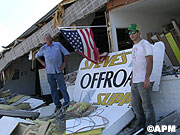| ||||||||||||||||||||||||
By MARTHA MENDOZA
AP National Writer
New Orleans neighborhoods, once lined with old live oaks, charming cottages and imposing mansions, had been proof of the ease with which black and white could live side by side. With the exception, perhaps, of the toniest areas of St. Charles Avenue, and the poorest blocks of housing projects, black and white homeowners chatted to each other from their front porches and greeted each other as they walked their dogs down the streets.
While Hurricane Katrina had no deliberate target as it ravaged the Gulf Coast, in the aftermath it's clear that the victims are mostly black and mostly poor. So many photographs from the devastation of New Orleans show the same faces: Desperate. Grief-stricken. Black.
"Love has no color," Cassandra Robinson said huddling with her family in a parking entrance along New Orleans' Convention Center Boulevard. "But I've seen where this is all black and everybody else who is Caucasian, they're up high in the hotels."
In fact, those in hotels complained bitterly they also were neglected. But Robinson's comment echoes those of others who question the part race may have played in New Orleans' crippling crisis.
Would the response have been more urgent if the victims had been mainly white? Is economic class a factor even more than race?
The images of the black poor struggling in New Orleans' chaos should be "a powerful wake-up call," said Dr. Jeff Johnson, a professor at the University of Maryland's School of Medicine.
"The message is that these people are in some sense abandoned, and that's why they're so angry," he said, "but that abandonment occurred not just around this storm. They've been abandoned by our society in the last decade. That's something as a society we have to acknowledge and grapple with."
Jesse Jackson said racial injustice and indifference to black suffering was at the root of the disaster response. But Secretary of State Condoleezza Rice, the administration's highest-ranking black, dismissed any such suggestion.
Although she agreed that the black community has been heavily affected, Rice said "nobody wants to see Americans suffer, and I think everybody understands that."
In Orleans Parish, where the boundaries are the same as the city limits, 66.6 percent of the residents are black. The black population nationwide is 12.1 percent.
D.J. Kelly, stood on a wet New Orleans sidewalk Friday with an American flag that he plucked from a gutter and washed with "some of my precious water." Kelly, who is black, said the disaster has nothing to do with the color of anyone's skin.
"Don't make it seem like no racial thing," he said. "That's not the way I feel. We all is in this together."
Black members of Congress, however, denounced the slow federal response to the storm.
"We cannot allow it to be said by history that the difference between those who lived and those who died in the great storm and flood of 2005 was nothing more than poverty, age or skin color," said Rep. Elijah E. Cummings, D-Md. "It would be unconscionable to stand by and do nothing."
New Orleanians were divided not so much by race as by economic class, a daily fact of life in a city where birthlines mean much. Sen. Mary Landrieu, a blue-eyed blonde, is the daughter of a former mayor. Marc Morial, who is light-skinned, followed his father into the mayor's office.
The political power structure is, to the eye, firmly controlled by people with African blood in their veins; most of the economic power of the city is held in very white hands.
Some even point to the city's geography: uptown New Orleans, around Tulane University, was mostly white and affluent; the areas north of the French Quarter and east of downtown tended to be poorer and more heavily populated by minorities.
When 80 percent of the city's population, according to the mayor, evacuated before Hurricane Katrina, that left behind those with no cars, no resources, no way out. Twenty-one percent of Orleans Parish households earn less than $10,000 a year. Nearly 27,000 families are below the poverty level. Most of those families are black.
Larry E. Davis, director of the University of Pittsburgh's Center on Race and Social Problems, said images of the disaster are an embarrassment to this nation.
"It suggests that the residuals of a racist legacy are still very much intact," he said. "It's as though you are looking at a picture of an African country."
Racial disparity in access to health care has been documented. Last December, the American Journal of Public Health reported that 886,000 African American deaths could have been prevented between 1991-2000 if they had the same care as whites.
There has been an outpouring of donations from throughout the United States in response to the images seen in news coverage - but might it have been greater if those images did not show black faces?
"I do think the nation would be responding differently if they were white elderly and white babies actually dying on the street and being covered with newspapers and shrouds and being left there," said David Billings of The People's Institute, a 25-year-old New Orleans-based organization focused on ending racism.
Ben Burkett, a black farmer whose fields of kale, spinach and broccoli and acres of soft pine trees were wiped out by Katrina, said the initial disaster made no distinctions, but he expects relief to be inherently biased.
"The eye of the storm made everybody equal, black or white, rich or poor, big house or small house," he said. "But believe me, when the relief comes - and we haven't seen anything yet - the small farmer is going to be at the end, and the small black farmer is going to be at the end of that.
"Basically I expect it because that's the way it's always been."




